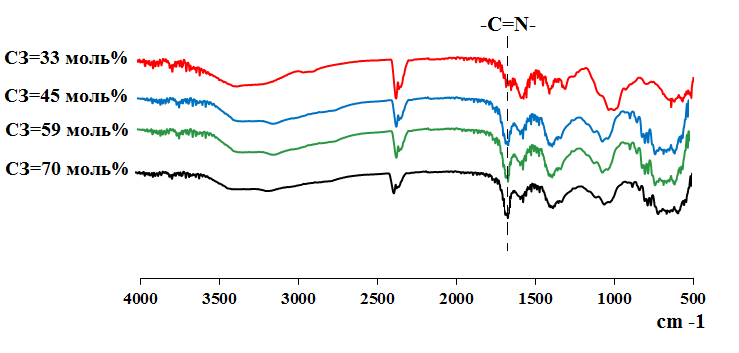PECULIARITIES OF SYNTHESIS AND ANTIMICROBIAL PROPERTIES OF GUANIDINE-CONTAINING CAR-BOXYMETHYLCELLULOSE DERIVATIVES
UDC 541.6.69:615.01
Abstract
The article presents data on the synthesis and antimicrobial properties of guanidine-containing carboxymethylcellulose derivatives with different physical and chemical characteristics. The regularities of the reaction of nucleophilic substitution of aldehyde groups of modified Na-carboxymethylcellulose (Na-CMC) by guanidine under different conditions are studied. Based on the results obtained, it was found that the limit replacement of reactive electrophilic groups with nucleophilic reagent depends on the pH value of the medium, molar ratio of guanidine and the degree of oxidation of cellulose ester. By varying the reaction conditions and the number of aldehyde groups in the oxidized Na-CMC composition, the azometin derivatives differing in the content of nitrogen-containing fragments in the polymer chain were obtained. Chemical restoration of labile azomethine bonds was performed and water-soluble derivatives containing strong amino-bound guanidine groups were synthesized. The study shows and substantiates the influence of structural indices (degree of substitution, quantitative guanidine content, pKα values and nature of counterion) of macromolecular systems on antibacterial and antifungal properties. The developed approach of synthesis opens prospects for creation of antimicrobial derivatives with regulated physical and chemical characteristics and set biologically active properties.
Downloads
Metrics
References
Dang X., Liu P., Yang M., Deng H., Shan Z., Zhen W. Cellulose, 2019, vol. 26, pp. 9503–9515. DOI: 10.1007/s10570-019-02747-9.
Asere T.G., Mincke S., Folens K. Reactive and Functional Polymers, 2019, vol. 141, pp. 145–154. DOI: 10.1016/j.reactfunctpolym.2019.05.008.
Akhmedov O.R., Shomurotov Sh.A., Turayev A.S. Uzbekskiy khimicheskiy zhurnal, 2013, no. 1, pp. 30–33. (in Russ.).
Akhmedov O.R., Shomurotov Sh.A., Rakhmanova G.G., Turaev A.S. Russ. J. of Bioorg. Chem., 2017, no. 7, pp. 718–721. DOI: 10.1134/S1068162017070020.
Akhmedov O.R., Shomurotov Sh.A., Turaev A.S., Vaili A. Chemistry for Sustainable Development, 2017, vol. 25, pp. 139–143.
Syutkin V.N., Nikolayev A.G., Sazhin S.A., Popov V.M., Zamoryanskiy A.A. Khimiya rastitel'nogo syr'ya, 2000, no. 1, pp. 5–25. (in Russ.).
Medusheva Ye.O., Filatov V.N., Ryl'tsev V.V., Belov A.A., Kulagina A.S. i dr. Farmatsiya, 2016, no. 1, pp. 52–56. (in Russ.).
Gumnikova V.I. Sintez dial'degiddekstrana i dial'degidkarboksimetiltsellyulozy i ikh khimicheskiye pre-vrashcheniya: diss. … kand. khim. nauk. [Synthesis of dialdehyde dextran and dialdehyde carboxymethyl cellulose and their chemical transformations: diss. ... Cand. chem. sciences]. Moscow, 2014, 137 p. (in Russ.).
Guben-Veyl'. Metody organicheskoy khimii. [Organic chemistry methods]. Moscow, 1967, vol. 2, 1032 p. (in Russ.).
Rawlinson L.B., Ryan S.M., Mantovani G., Syrett J.A, Haddleton D.M., Brayden D.J. Biomacromolecules, 2010, vol. 11(2), pp. 443–453. DOI: 10.1021/bm901166y.
Tishchenko E.V., Iozep A.A., Ivin B.A. Russ. J. of Appl. Chem., 2002, vol. 75, no. 4, pp. 680–682.
Snezhko V.A., Komar V.P., Khomyakov K.P., Virnik A.D., Zhbankov R.G., Rozenberg G.Ya., Rogovin Z.A. Vysokomolekulyarnyye soyedineniya, 1974, vol. 16, no. 10, pp. 2233–2239. (in Russ.).
Sarymsakov A.A., Nadzhimutdinov Sh., Tashpulatov Yu.T. Khimiya prirodnykh soyedineniy, 1998, no. 2, pp. 212–217. (in Russ.).
Shomuratov Sh.A., Murodov E.A., Turayev A.S. Khimiya rastitel'nogo syr'ya, 2006, no. 2, pp. 25–28. (in Russ.).
Keshk S.M.A.S., Ramadan A.M., Bondock S. Carbohydrate Polymers, 2015, vol. 127, pp. 246–251. DOI: 10.1016/j.carbpol.2015.03.038.
Wang P., He H., Cai R., Tao G., Yang M., Zuo H., Wang Y. Carbohydrate Polymers, 2019, vol. 212, pp. 403–411. DOI: 10.1016/j.carbpol.2019.02.069.
Tishchenko Ye.V. Vzaimodeystviye amino- i gidroksi(okso)proizvodnykh geterotsiklov s polisakharidami – novyy put' sinteza BAV: avtoref. dis. … kand. khim. nauk. [The interaction of amino and hydroxy (oxo) derivatives of heterocycles with polysaccharides - a new way of synthesis of biologically active substances: author. dis. ... Cand. chem. sciences]. St.-Petersburg, 2003, 26 p. (in Russ.).
Kozlova Yu.S., Rogovin Z.A. Vysokomolekulyarnyye soyedineniya, 1960, vol. 2, no. 4, pp. 614–618. (in Russ.).
Shatalov D.O. Razrabotka i standartizatsiya metodov kontrolya kachestva, razvetvlennogo oligogeksametilenguanidin gidrokhlorida: diss. … kand. farm. nauk. [Development and standardization of quality control methods for branched oligohexamethylene guanidine hydrochloride: diss. ... Cand. farm. sciences]. Moscow, 2015, 137 p. (in Russ.).
Afinogenov G.Ye., Panarin Ye.F. Antimikrobnyye polimery. [Antimicrobial polymers]. St.-Petersburg, 1993, 264 p. (in Russ.).

Copyright (c) 2021 chemistry of plant raw material

This work is licensed under a Creative Commons Attribution 4.0 International License.

This work is licensed under a Creative Commons Attribution 4.0 International License.
The authors, which are published in this journal, agree to the following conditions:
1. Authors retain the copyright to the work and transfer to the journal the right of the first publication along with the work, at the same time licensing it under the terms of the Creative Commons Attribution License, which allows others to distribute this work with the obligatory indication of the authorship of this work and a link to the original publication in this journal .
2. The authors retain the right to enter into separate, additional contractual agreements for the non-exclusive distribution of the version of the work published by this journal (for example, to place it in the university depository or to publish it in a book), with reference to the original publication in this journal.
3. Authors are allowed to post their work on the Internet (for example, in a university repository or on their personal website) before and during the review process of this journal, as this may lead to a productive discussion, as well as more links to this published work.











